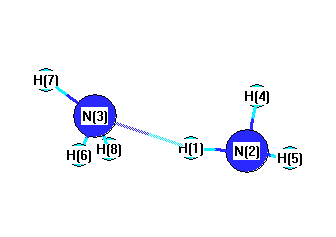Vibrational Frequencies calculated at B3LYPultrafine/6-31G*
| Mode Number |
Symmetry |
Frequency
(cm-1) |
Scaled Frequency
(cm-1) |
IR Intensities
(km mol-1) |
Raman Act
(Å4/u) |
Dep P |
Dep U |
|---|
| 1 |
Ag |
3560 |
3410 |
0.00 |
|
|
|
| 2 |
Ag |
3430 |
3286 |
0.00 |
|
|
|
| 3 |
Ag |
1734 |
1661 |
0.00 |
|
|
|
| 4 |
Ag |
1172 |
1123 |
0.00 |
|
|
|
| 5 |
Ag |
498 |
477 |
0.00 |
|
|
|
| 6 |
Ag |
158 |
151 |
0.00 |
|
|
|
| 7 |
Au |
3569 |
3419 |
0.42 |
|
|
|
| 8 |
Au |
1750 |
1676 |
29.62 |
|
|
|
| 9 |
Au |
265 |
254 |
120.92 |
|
|
|
| 10 |
Au |
111 |
107 |
31.34 |
|
|
|
| 11 |
Bg |
3569 |
3419 |
0.00 |
|
|
|
| 12 |
Bg |
1737 |
1664 |
0.00 |
|
|
|
| 13 |
Bg |
145 |
139 |
0.00 |
|
|
|
| 14 |
Bu |
3559 |
3409 |
20.95 |
|
|
|
| 15 |
Bu |
3432 |
3288 |
28.09 |
|
|
|
| 16 |
Bu |
1706 |
1634 |
15.39 |
|
|
|
| 17 |
Bu |
1144 |
1096 |
346.03 |
|
|
|
| 18 |
Bu |
102 |
97 |
325.45 |
|
|
|
Unscaled Zero Point Vibrational Energy (zpe) 15819.7 cm
-1
Scaled (by 0.958) Zero Point Vibrational Energy (zpe) 15155.2 cm
-1
See section
III.C.1 List or set vibrational scaling factors
to change the scale factors used here.
See section
III.C.2
Calculate a vibrational scaling factor for a given set of molecules
to determine the least squares best scaling factor.
Charges, Dipole, Quadrupole and Polarizability
Charges from optimized geometry at B3LYPultrafine/6-31G*
Charges (e)
| Number |
Element |
Mulliken |
CHELPG |
AIM |
ESP |
| 1 |
H |
0.327 |
|
|
|
| 2 |
N |
-0.917 |
|
|
|
| 3 |
N |
-0.917 |
|
|
|
| 4 |
H |
0.295 |
|
|
|
| 5 |
H |
0.295 |
|
|
|
| 6 |
H |
0.327 |
|
|
|
| 7 |
H |
0.295 |
|
|
|
| 8 |
H |
0.295 |
|
|
|
Electric dipole moments
Electric dipole components in Debye
(What's a Debye? See section
VII.A.3)
| |
x |
y |
z |
Total |
| |
0.000 |
0.000 |
0.000 |
0.000 |
| CHELPG |
|
|
|
|
| AIM |
|
|
|
|
| ESP |
|
|
|
|
Electric Quadrupole moment
Quadrupole components in D Å
Polarizabilities
Components of the polarizability tensor.
Units are
Å
3 (Angstrom cubed)
Change units.
| |
x |
y |
z |
| x |
0.000 |
0.000 |
0.000 |
| y |
0.000 |
0.000 |
0.000 |
| z |
0.000 |
0.000 |
0.000 |
<r2> (average value of r
2) Å
2
| <r2> |
64.468 |
| (<r2>)1/2 |
8.029 |
